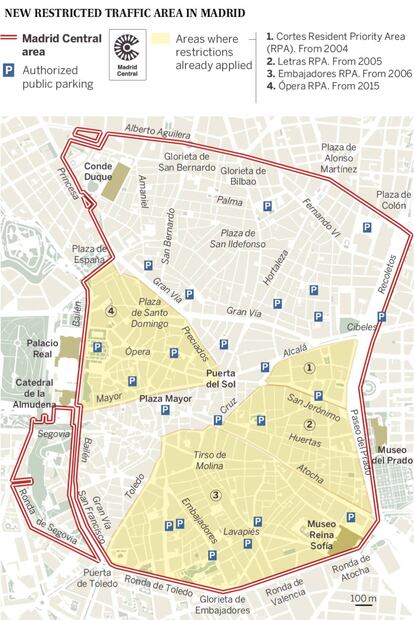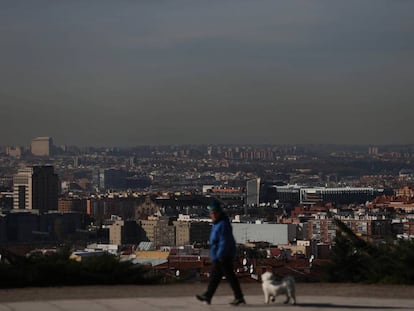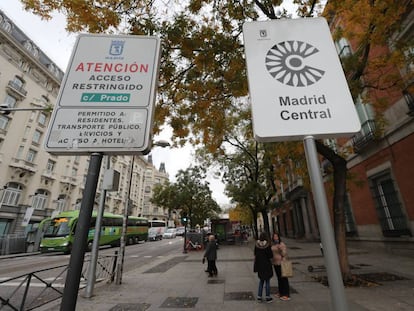Emissions fall in Madrid city center thanks to new traffic restrictions
The level of nitrogen oxide has dropped by 38% after local authorities made 472 hectares off-limits to most vehicles at the end of November


Greenhouse gas emissions have fallen in the center of Madrid after City Hall launched a pioneering program on November 30, 2018 to curb air pollution and increase the space given to pedestrians.
Viewed as a legacy-making project for Mayor Manuela Carmena, of the leftist Ahora Madrid party, the Madrid Central program made 472 hectares of the city center off-limits to traffic, except for local residents and public transportation. Some private vehicles can also enter the area if they are going to park in a public parking lot (see sidebar).
The air you breathe in the center of Madrid is better now
Environmental activist Juan Bárcena
According to a study conducted to measure the environmental impact of Madrid Central, emissions of nitrogen oxide (NOx), a polluting gas released by vehicles, fell by 38% in Madrid’s center the first month the program was implemented, while carbon dioxide (CO2) emissions dropped by 14.2%.
The study by the Technical University of Madrid, which looked at both traffic flow and car types in the restricted area, found that emissions also fell across the city, with NOx and CO2 emissions falling by 9% and 2%, respectively, in December.
There are two main factors that influence pollution: polluting gases (which go into the atmosphere) and the weather, which can either reduce pollution with favorable conditions (when wind and rain clear the air) or exacerbate it with unfavorable ones (sunny days without clouds or wind).
Between November 30, 2018, and February 25, 2019, Madrid experienced 42 days of unfavorable weather, according to the national weather service AEMET. In the same period from the year before, the number was only 19.
“There are climatological factors that we can’t influence. But the ones that we can, which are vehicle emissions, have decreased and this helps reduce pollution,” explained Inés Sabanés, the local environment and mobility chief. “These rigorous measures can positively affect the whole city,” she added, referencing the traffic restrictions introduced under Madrid Central.

Air quality in the center has also improved, with pollution falling by 8.9% compared to the historic average for the December-March period, according to measurements taken from the Plaza del Carmen monitoring station, the only one located within the Madrid Central area.
“There are 24 monitoring stations in Madrid and the one at Plaza del Carmen was always one of the three worst in the city,” said Juan Bárcena from Ecologists in Action, a collective representing more than 300 environmental groups in Spain. “However, since the implementation of Madrid Central, it has become one of the top five and is only ranked behind the stations located in green areas. The air you breathe in the center of Madrid is better now.”
Pollution in the center has fallen by 8.9%
According to Bárcena, pollution has fallen more in the center than in any other place in the city. “The drop is so significant that it compensates for the bad weather we’ve had at the beginning of the year. Pollution levels have been very high, but in Plaza del Carmen they’ve improved,” he said.
Public transport in the city has also improved thanks to Madrid Central, said Sábanes. According to the local environment and mobility chief, “Madrid’s public transport company (EMT) has added 25,000 more daily trips to the Madrid Central area, and 50,000 more if the whole network is taken into account. It has also improved the frequency of buses.”
The number of people traveling on the Metro underground rail network has also increased, while traffic on the city’s popular Gran Vía avenue and other streets in the area has dropped by 26%, said Sábanes. “Expectations are being met, the numbers are very good. The rate at which emissions are falling is a very positive trend, which complies with what the European Union has asked of us,” she explained.
Improving the air quality in cities is an EU mandate, and the European Commission has set 2020 as the deadline for Madrid to meet its targets. City officials say that Madrid Central will reduce emissions by 40% as a result of eliminating through traffic and banning the biggest polluters from the area.
Fines
From Saturday, March 16, drivers who enter the Madrid Central zone without permission will be fined €90 (or €45 if the amount is paid immediately).
Residents may enter the area in their vehicles but only park in their own neighborhood. Occasional visitors may be allowed in by residents.
Non-residents whose vehicles hold CERO and ECO energy labels may also enter the area. And those with B or C energy labels may only enter to park in a private or public parking lot, not in the street. Exceptions will also be made for people with reduced mobility, ambulances, taxis, private-hire cars and delivery vans. Electric vehicles will also be allowed into Madrid Centro.
English version by Asia London Palomba.
Tu suscripción se está usando en otro dispositivo
¿Quieres añadir otro usuario a tu suscripción?
Si continúas leyendo en este dispositivo, no se podrá leer en el otro.
FlechaTu suscripción se está usando en otro dispositivo y solo puedes acceder a EL PAÍS desde un dispositivo a la vez.
Si quieres compartir tu cuenta, cambia tu suscripción a la modalidad Premium, así podrás añadir otro usuario. Cada uno accederá con su propia cuenta de email, lo que os permitirá personalizar vuestra experiencia en EL PAÍS.
¿Tienes una suscripción de empresa? Accede aquí para contratar más cuentas.
En el caso de no saber quién está usando tu cuenta, te recomendamos cambiar tu contraseña aquí.
Si decides continuar compartiendo tu cuenta, este mensaje se mostrará en tu dispositivo y en el de la otra persona que está usando tu cuenta de forma indefinida, afectando a tu experiencia de lectura. Puedes consultar aquí los términos y condiciones de la suscripción digital.
More information
Archived In
Últimas noticias
Most viewed
- Sinaloa Cartel war is taking its toll on Los Chapitos
- Oona Chaplin: ‘I told James Cameron that I was living in a treehouse and starting a permaculture project with a friend’
- Reinhard Genzel, Nobel laureate in physics: ‘One-minute videos will never give you the truth’
- Why the price of coffee has skyrocketed: from Brazilian plantations to specialty coffee houses
- Silver prices are going crazy: This is what’s fueling the rally










































